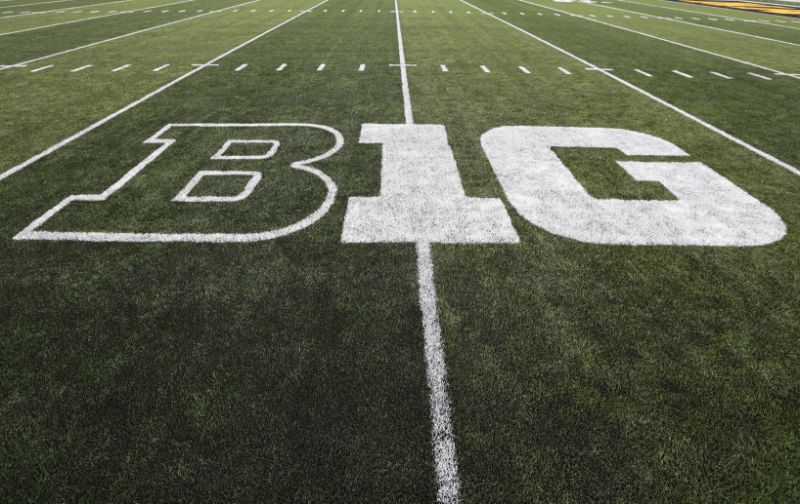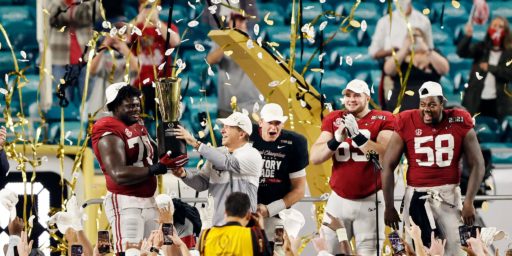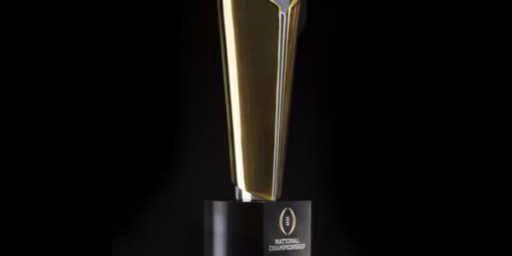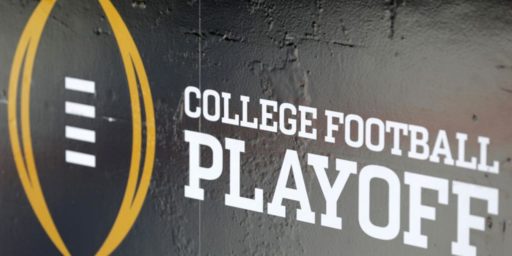Big Ten Football Back October 24
Yet another twist in an ongoing saga.

The Big Ten conference has been all over the map in its response to the COVID-19 pandemic. On July 9, it announced a conference-only schedule. A month later, it canceled the Fall season, hinting that it might attempt to play in the Spring. Now, it has done a 180, announcing that it will begin play in five weeks.
ESPN‘s Adam Rittenberg and Heather Dinich (“Big Ten football to resume weekend of Oct. 24“):
The Big Ten will kick off its football season the weekend of Oct. 24 after the league’s presidents and chancellors unanimously voted to resume competition, citing daily testing capabilities and a stronger confidence in the latest medical information, the conference announced Wednesday morning.
Each team will attempt play eight games in eight weeks, leaving no wiggle room during the coronavirus pandemic before the Big Ten championship game on Dec. 19. That date will also feature an extra cross-division game for each school, with seeded teams in each division squaring off.
The Big Ten would complete its season before the Dec. 20 Selection Day for the College Football Playoff. Fans are not expected at Big Ten games, which will be held on campus throughout the season.
Wisconsin athletic director Barry Alvarez said the schedule will be released later this week.
In a separate piece (“Big Ten football is back: What you need to know“), Rittenburg and Dinich explain what it all means:
What was the most important factor in the Big Ten voting to play?
The medical information and resources around COVID-19 improved significantly, especially the availability of rapid testing programs. Big Ten teams had several outbreaks during the summer, and contact tracing had been a significant obstacle without rapid testing in place. Many wondered how schools such as Rutgers, Northwestern, Illinois and Maryland would ever get around their state restrictions to practice in pads and eventually play. The emergence of several reliable rapid-testing options eased concerns about contact tracing, and increased confidence about having minimal interruptions during the regular season, which can’t afford too many bumps if the Big Ten wants to be part of the College Football Playoff.
What happened in the meetings and how was the vote decided?
The conversations began in earnest Saturday, with a medical presentation to a steering committee comprised of eight presidents and chancellors. That group served as a buffer, and was impressed enough that it called a full board meeting with all 14 presidents and chancellors Sunday.
The marathon meeting Sunday, which included a three-part presentation from each of the Big Ten’s return to competition task force subcommittees, was again focused on the updated medical information, as the league had cited medical reasons for its initial postponement. The medical subcommittee presented at least four new rapid-testing options and how the developments will ease some of the challenges around contact tracing. Presidents and chancellors also heard about the potential football schedule and how it will work with the Big Ten’s television agreement. A start date during the weekend of Oct. 17 was discussed before deciding on the weekend of Oct. 24.
Could some Big Ten teams still not play this fall?
All 14 Big Ten teams will attempt to play this fall. The developments around rapid testing have eased concerns of schools in areas with more restrictions around contact and gatherings. Wisconsin last week announced a two-week pause for all football activities, but the break is set to end next week, and athletic director Barry Alvarez and coach Paul Chryst think the team needs only three additional weeks to be ready for competition. Maryland, which paused activities Sept. 3, resumed practices in football late last week.
During a news conference Monday, Wisconsin chancellor Rebecca Blank said all of the schools were going to “move together.”
“We’re all going to play or not if we possibly can,” she said. “This isn’t going to be a school-by-school thing.”
Could the Big Ten be ready in time for the College Football Playoff?
With a late October start date, the Big Ten can still finish its season and crown a champion in time to be considered for a semifinal spot, but it has to be approved by the playoff’s management committee. All 10 of the FBS commissioners and Notre Dame athletic director Jack Swarbrick would determine whether the Big Ten can rejoin the CFP. ACC commissioner John Swofford, SEC commissioner Greg Sankey and Big 12 commissioner Bob Bowlsby will carry the most weight in the room, as they will have navigated their leagues through longer schedules. It would be difficult for them to say no, but they also probably won’t be thrilled with the Big Ten playing a shortened season.
What does this mean for the Pac-12?
The Pac-12 remains on a later timeline to potentially kick off its fall season, mainly because of local regulations in California (four teams) and Oregon (two teams). Half the conference still has not been cleared by public health officials to resume contact practices, let alone games. The league’s presidents and chancellors wouldn’t consider a vote to return until that status changes.
The league already has an agreement for rapid testing with Quidel Corporation, and hopes to have equipment in place by the end of the month. Sources say a mid-November start is likely the earliest the Pac-12 could get on the field, presuming the local regulation hurdles are cleared.
I was incredibly skeptical that we could—much less should—play college football this year. Given that so many colleges and universities have either chosen to go entirely remote for classes this semester or tried unsuccessfully to return to normal, it seemed absurd that we would try to field sports teams.
And yet here we are. The Atlantic Coast Conference resumed games two weeks ago, with mixed success. Most notably, Virginia Tech has had to postpone both of its games. The Southeastern Conference kicks off on September 26, with my Alabama Crimson Tide playing at the University of Missouri Tigers.
If the sport is to be played, I’m happy that the Big Ten is back in the mix. It would have been somewhat hollow to crown a national champion in a season where two of the Power 5 conferences were sitting out.
Still, there’s something surreal about the whole thing. The Alabama campus, in particular, has been a COVID hotspot and drawn national attention for the failure of students to practice social distancing and wear masks. But, given the combination of the politicization of the virus and the tendency of college-age folks to crave social interaction and flout the rules, that was a foreseeable outcome.
In terms of football alone, it’s also rather strange that the conferences will play very different schedules. It’s hard enough for the selection committee to rank teams from different conferences whose schedules overlap very little. Add in the fact that some schools are only going to play eight or nine games while others play ten or eleven. Obviously, it’s much easier to go undefeated playing fewer games.






That question and answer session was absolute nonsense, especially stuff about “knowing more medically”. Semantically null. It was just words thrown up against the wall. Given what we already know, a not insignificant number of these players are going to get the disease and “recover” but display long term effects on their lungs. It’s going to end up shortening or eliminating any chance for a professional career, but hey – the coaches will get payed and the rich alumni will get their skyboxes. Who gives a f* about the farcically named “student athletes”.
And:
So these schools, who insist their programs are run in the best interest of the so-called students, see all this uncertainty and say – “Yeah, I’m good with gambling with these kids lives and careers!”
@MarkedMan:
I both think this is objectively true and that it’s more complicated than that.
Football is just an incredibly big part of life for these communities and the athletes themselves. Even at the big-time programs like Ohio State, Penn State, Wisconsin, and Nebraska, only a relative handful of these students will go on to play pro ball. So, this is their last chance to play at a big-time level. Taking that away from them is a really big deal.
Further, we do have more information now: the success of the pro leagues in dealing with COVID. It’s doable even without a bubble. The NFL held a truncated training camp and is now playing games with, thus far, no infections.
I think college is different for a variety of reasons but sports programs—and football in particular—are more disciplined than the campus as a whole. I think this is doable—but still a hell of a risk.
It is immoral to start a college football season when most universities have become Covid hotspots. Just yesterday, Coach Orgeron of LSU revealed that “most” of his team has, or has gotten, Coivd-19.
https://www.cnn.com/2020/09/15/us/lsu-covid19-trnd/index.html
Given what we already know about how Covid attacks the respiratory system of young athletes, it’s immoral that we’re even contemplating playing, much less doing it.
https://www.cnn.com/2020/09/14/health/covid-heart-inflammation-athletes-study/index.html
I’m amazed by the stupidity of a not small segment of the American public.
I should be shocked, but I’m not.
@James Joyner: James, I’m sorry, but “It’s complicated” just doesn’t cut it. Eddie is dead on:
Pulling out a quote from the article Eddie cited:
@James Joyner:
Yes. It’s true. No. It’s not more complicated than that. Universities want the cash that comes from football, the health and safety of the athletes, and, by extention, the students, be damned.
So what. That’s not a reason to create a bigger public safety issue than we already have. We are at a plateau, and the cases aren’t coming down fast enough. We’re going to be a crappy level when this thing starts up again in a few weeks, and football will then have to be shut down again. It’s gonna happen.
Bullshit. Cancel the season for a year. Give everyone another year of eligibility. Those who are good enough will go straight to the NFL. The rest get their one last shot of college glory. That’s a better, safer choice for the majority of students. athletes, and the general public.
The St. Louis Cardinals would disagree.
With billionaire owners footing the bill for daily testing, and strict safety protocols in place. What University has the resources to do such a thing? And how do you keep college kids in a bubble when their whole lives are built around social contact?
No. It’s not doable at the college level. And it’s a risk not worth taking.
Bread and circuses. So some kids get sick. So some of them have lifelong health complications that will, among other things, doom their chance of becoming professional athletes. So some kids die. The show must go on. How else are you going to rake in that sweet alumni money? Not to mention TV!
Americans have never been reluctant to trade lives for cash, especially when those lives are preponderantly Black.
And there is, of course, a Trumpian angle to all this. Seems he pushed for the Big Ten to start the season prior to the election, and even offered federal assistance.
@James Joyner
The NCAA has already given all football players (and other fall sports?) another year of eligibility whether they play this year or not. So not really taking anything away from them.
Further, multiple teams so far have played while numerous players ssat due to the Trump Plague. Against a team like Alabama, this has long term health implications for the players that are not sitting out.
The governor of Michigan, while proclaiming how she was a big sports supporter and fan, was happy when the season was cancelled earlier. Most likely it was her thinking that this would be one season when Ohio State did not beat Michigan! I don’t know what changed her mind. It could be the monetary losses or the public opinion that swayed her. Or getting left behind and standing on the outside looking in.
Practice will start almost immediately. Most coaches were in favor of getting the season going. Coach Frost of Nebraska was looking at the possibility of taking on games with teams outside of their conference if the Ten season was over.
Football is big money for the cities, small towns, and farm areas up there. The athletic boosters might have gone elsewhere and taken their money with them.
@Tyrell:
Not once in your post did you mention the possibility of these players contracting the disease and then giving it to their parents or grandparents. That’s what is going to happen. Why do Americans continue to think that we’re somehow special and that this disease will stop with athletics?
It’s insane.
This is semi-embarrassing.
I was a jock. Not a jock jock, but I was on the football team, the hockey team, and the golf team.
And I was pretty good too. Started as free safety as a junior. I can run backwards nearly as fast as forwards and have good tactical sense. Good hands.
Passable as a right winger. Second string.
Actually decent golfer. #2. Straight and steady down the middle and two putt. Back then if you shot 80 you had a great shot at winning. Nowadays they grow prodigies in capsules. It’s insane how good they are that young.
I really enjoyed sports, especially football.
I was also slightly embarrassed I liked it and was good at it. I was a guy who was not jockish.
But when we played I wanted to smash and destroy. Secondary defense is stupid hella fun when you have their number.
There was active dichtomy.
I was torn on this until a friend, whose son is an athlete, told me he wants them to play. Because on campus, they can keep them in their own dorms and it’s way safer than sending them home to party with their friends. If athletic programs take this seriously — admittedly a big if — I think it works out better in the end.
@Hal_10000:
As I wrote above, good luck with that. If Pro Athletes, getting paid millions of dollars per year, can’t stay clean inside the bubble, why on earth does ANYONE think college kids are going to be better.
https://www.thedailybeast.com/rockets-player-danuel-house-evicted-from-nba-bubble-for-unauthorized-guest
https://www.si.com/soccer/2020/09/07/mason-greenwood-phil-foden-england-iceland-girls-bubble
I know the Gophers will finish near the top of the middle of the pack.
Likely 7-4. Good year is 8-3. Bad year is 6-5. It has been thus most of my life.
Thankfully, they also play hockey.
@EddieInCA: You’re not seeing the issue clearly. This isn’t about kids getting sick; it’s about Tyrell getting a good “Game of the Week” to watch. Maybe even 2 or 3–because he seems to live in an the Eastern time zone. There’ve been no proven outbreaks in NASCAR, the states are okay with their ability to handle the outbreak (which won’t happen anyway because NASCAR), everything’s settled. Put on the pads and start working at getting your chop block to look legal already!
One night at a house party I walked into a room where a bunch of folks were watching Gophers vs UMD. Super intense rivalry.
Gopher dude just nailed a shot in the three hole as I walked through the door.
I did not know the room and I was absolutely peaking on two grams of shrooms ingested an hour back so I decided to say “Everyone should score a goal all the time!”
I stand by that statement to this day. Totally valid.
My 19 year old self was channeling Buddha.
Told ya’ll. Weeks ago. Never doubted it.
My date was off, I predicted a slight delay, with the first game kicking off at the end of September.
Simply too many people would lose too much money. Big money.
UNL ’84.
I remember the days when we didn’t embarrass ourselves. As does Scott Frost.
@EddieInCA: Thanks for your reply to my report and you have a point there. There have been some activities going on that involve large groups of people with safety procedures and precautions followed. NASCAR has been putting limited numbers of fans in the stands. Several amusement parks have reopened. I have not heard of any big problems there.
I am not a big football fan, excepting Clemson and Notre Dame.
Every blue moon I will go up the road to a small college. I park free on the street. Admission is about $5. I can sit on some bleachers or take my chair and sit on the grass. I take my own drinks and snacks in. After the game, some players hang around to talk and have pictures made. Others head for the showers and then back to the books. Try that at pro or big college games .
Tyrell, I have tried to cut you all sorts of breaks and approached each of your posts as something new and unexpected. But “Clemson and Notre Dame”? We are done now. My every suspicion of you confirmed. My every concern about you confirmed. I deem each of your future posts as tl;dr and even the replies as unworthy of my time.
So what we’re saying is that college football is so incredibly important to the soul of the nation that the student-players must risk their lives and health to make us whole.
Kind of wondering why, if this sport is so important to the entire nation we demand that all these young men be willing to sacrifice themselves or their future, the NCAA continues to insist that they must not be paid a nickel for their services.
Kind of like all the “essential workers” in meat packing plants — they are so important we must force them back to work, but not so important they should be paid more to take on the extra risk… or that their employers should be expected to lay out money to protect them.
@James Joyner: “Football is just an incredibly big part of life for these communities and the athletes themselves.”
Going to see movies and plays in theaters is just an incredibly big part of my life. Meeting with colleagues in bars and restaurants is an incredibly big part of my life. Spending two weeks every six months in a resort surrounded by my colleagues and the hundred-plus students in the low-res program I teach in is an incredibly big part of my life.
And I can’t experience any of these — or other incredibly big parts of my life — because the world has been engulfed in a pandemic. Not because some mean politician doesn’t approve of my choices or evil elites are trying to deprive me of my way of life — because we are in a global emergency, and the only way to stop it, and to prevent millions of unnecessary deaths — is to shut down these things for a while.
Why is this so hard to understand? I’m pretty sure that during WW2, most people didn’t squeal with pleasure when they could only buy a small amount of meat every week or had to grow their own vegetables. But back then the American people seemed to understand that there are actually sometimes things that are more important than whatever they feel like doing whenever they feel like doing it.
It’s not that Americans have failed the marshmallow test — it’s that we have decided that not only do we get one marshmallow now, one later, and as many as we want whenever we want it, but that anyone who doesn’t grab all the marshmallows is a sucker and a loser.
@wr:
The thing is WW2 was forced on the nation. The government just came and took if you didn’t want to give; history talks about things like Victory Gardens as great patriotic things we just did and not because there weren’t any decent veggies left after most were acquired by the Army. It’s a lot easier to deal with deprivation thrust upon you then to willing deprive yourself.
Additionally, you could still hit up the bar and movie theater during WW2. You were discouraged from wasting things that could be useful to the war effort but nobody was actively preventing you from going to the bar to drink or the Axis would win. Simply put, this would have happened back then too had it been COVID-44 instead of COVID-19. Angry anti-maskers would have still rebelled and selfishly spread the virus rather than have their freedumb impinged in any sort of way.
We mythologize WW2 a lot. They sacrificed because they *had* to and someone in power *made* them. The only difference now is we *have* to but precious few are willing to use the political capital to *make* people comply.